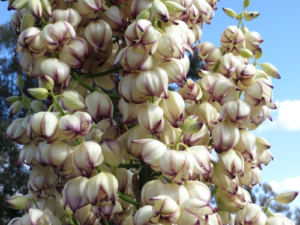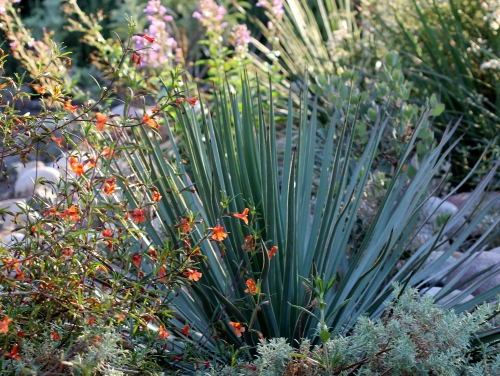Scarce rain, spring through fall, causes people to think of San Diego as desert, using mostly exotic, drought tolerant succulents in their landscaping. If you enjoy succulent gardens, please consider our wonderful native succulents. Two of five native California yuccas are available in nurseries. The Chaparral Yucca (Hesperoyucca whipplei), 2’ to 12’ tall and 2’ to 3’ across, matures in about 5 to 10 years shooting up a spike of many bell-shaped white to purplish flowers. After pollination the plant dies but the spike can remain for several years. In contrast the Mojave Yucca (Yucca schidigera), 1’ to 16’ tall and up to 5’ wide, has multiple spikes of cream and white flowers and continues to live after blooming.
 Both yuccas have a symbiotic relationship with specific Yucca moths: Tegeticula maculate for the Chaparral Yucca and Tegeticula yuccasella for the Mohave Yucca. Using them supports biodiversity. Adult moths lay eggs as they pollinate yuccas. Yuccas produce enough seed to feed the larva and grow the plant’s next generation.
Both yuccas have a symbiotic relationship with specific Yucca moths: Tegeticula maculate for the Chaparral Yucca and Tegeticula yuccasella for the Mohave Yucca. Using them supports biodiversity. Adult moths lay eggs as they pollinate yuccas. Yuccas produce enough seed to feed the larva and grow the plant’s next generation.
The Chaparral Yucca is very easy to grow here. It occurs naturally in Southern California and Baja California, Mexico, in the chaparral, coastal sage scrub, and oak woodland communities, plus sandy washes in the deserts and inland valleys. It is used as groundcover, on hillsides, is deer resistant and does well in bird gardens, attracting California Thrashers. It makes a fine accent plant but should not be close to walkways with its sharp leaves. Chaparral Yucca does well in clay and rocky soils, needing little or no summer watering. Plant this yucca with Mission Manzanita, Spiny Redberry, California Buckwheat, and California Sagebrush. Native Americans were able to use this plant for making sandals, cloth and rope. The Kumeyaay ate the stems and boiled flowers. The fruits were eaten raw or roasted, or ground into meal. The seeds were eaten roasted or ground into flour.
The Mojave Yucca is moderately easy to grow occurring in southern California in coastal sage scrub, mountain chaparral, and desert transition communities. It works well behind borders, as hedges, in bird and butterfly gardens and is deer resistant. Hummingbirds and many insects flock to it. It prefers sandy, rocky soil with organic and rock mulch and no summer watering. Companion plants include Lemonadeberry, Manzanitas, especially Mission Manzanita, Toyon Ceanothuses, Milkweeds, Giant Wild Rye, Sand Aster, Sagebrush, Monkeyflowers, Encelia californica, Buckwheat, Heartleaf Keckiella, Penstemon species, Salvias, Blue-eyed Grass, and Scrub Oaks. This plant is very useful. Formerly, sandals, bowstrings, cloth, soap from the roots, necklaces and toys from the seeds were made by the Kumeyaay, as well as tea and mush. It’s been used medicinally to fight arthritis and reduce inflammation. Today, it’s used as a food additive for livestock and pets, and to flavor soft drinks.
Workshop:
Create Habitat and Give Back to Nature with California Native Plants, Saturday, January 26, 2019, 9:00 AM 3:20 PM, Museum of Photographic Arts, Balboa Park: (https://www.cnpssd.org/events/winterworkshop2019).
Resources:
Calscape (https://calscape.org/), San Elijo Lagoon Conservancy: “Mojave Yucca” (https://www.sanelijo.org/plant-guide/mojave-yucca), “California Native Landscape” by Greg Rubin and Lucy Warren, CNPS (https://www.cnpssd.org/)
Photos courtesy of Calscape




